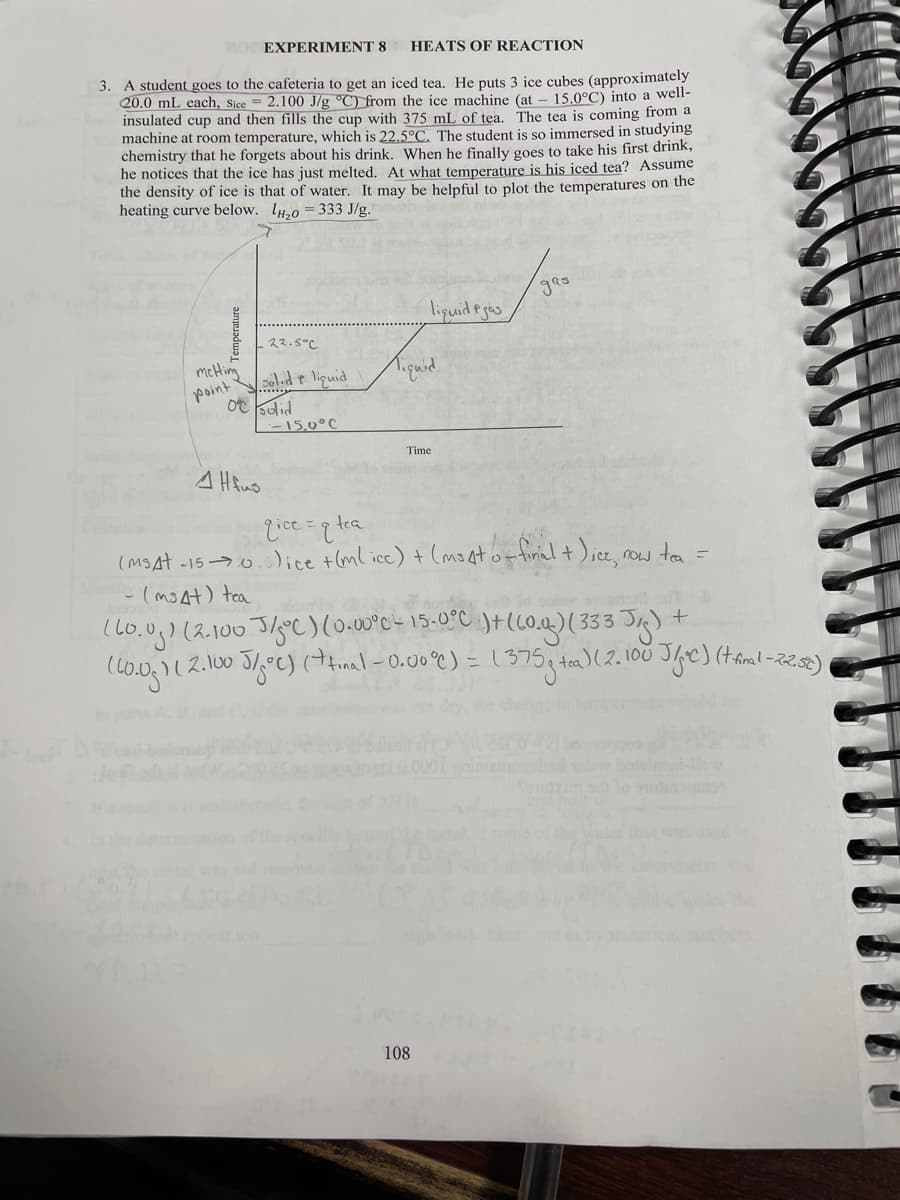3. A student goes to the cafeteria to get an iced tea. He puts 3 ice cubes (approximately 20.0 mL each, Sice = insulated cup and then fills the cup with 375 mL of tea. The tea is coming from a machine at room temperature, which is 22,5°C. The student is so immersed in studying chemistry that he forgets about his drink. When he finally goes to take his first drink, he notices that the ice has just melted. At what temperature is his iced tea? Assume the density of ice is that of water. It may be helpful to plot the temperatures on the heating curve below. lH,0=333 J/g. 2.100 J/g °C) from the ice machine (at – 15.0°C) into a well- %3D
3. A student goes to the cafeteria to get an iced tea. He puts 3 ice cubes (approximately 20.0 mL each, Sice = insulated cup and then fills the cup with 375 mL of tea. The tea is coming from a machine at room temperature, which is 22,5°C. The student is so immersed in studying chemistry that he forgets about his drink. When he finally goes to take his first drink, he notices that the ice has just melted. At what temperature is his iced tea? Assume the density of ice is that of water. It may be helpful to plot the temperatures on the heating curve below. lH,0=333 J/g. 2.100 J/g °C) from the ice machine (at – 15.0°C) into a well- %3D
Chemistry for Engineering Students
4th Edition
ISBN:9781337398909
Author:Lawrence S. Brown, Tom Holme
Publisher:Lawrence S. Brown, Tom Holme
Chapter9: Energy And Chemistry
Section: Chapter Questions
Problem 9.38PAE: 9.38 The energy densities of various types of coal are listed below: Anthracite 35 kJ/g...
Related questions
Question
I need help with this problem.

Transcribed Image Text:no EXPERIMENT 8
HEATS OF REACTION
3. A student goes to the cafeteria to get an iced tea. He puts 3 ice cubes (approximately
20.0 mL each, Sice = 2.100 J/g °C) from the ice machine (at – 15.0°C) into a well-
insulated cup and then fills the cup with 375 mL of tea. The tea is coming from a
machine at room temperature, which is 22.5°C. The student is so immersed in studying
chemistry that he forgets about his drink. When he finally goes to take his first drink,
he notices that the ice has just melted. At what temperature is his iced tea? Assume
the density of ice is that of water. It may be helpful to plot the temperatures on the
heating curve below. lo = 333 J/g.
lipuideges
22.5°C
meHim
point
ld e liguid
ot oodid
15,0°C
Time
leule
(MSAt -15 0.)ice +(ml ice) + (moator firial t);ce, now to =
こ(moat) tea
(lo.0g) (2.100 Jlye)(0-00°c- 15-0°C )+(L0.1)( 333 Jg) +
)(2.100 J/,°C)(inal-0.00°C) = 1375
(tfinal-225t)
that w sed
108
Expert Solution
This question has been solved!
Explore an expertly crafted, step-by-step solution for a thorough understanding of key concepts.
This is a popular solution!
Trending now
This is a popular solution!
Step by step
Solved in 5 steps

Knowledge Booster
Learn more about
Need a deep-dive on the concept behind this application? Look no further. Learn more about this topic, chemistry and related others by exploring similar questions and additional content below.Recommended textbooks for you

Chemistry for Engineering Students
Chemistry
ISBN:
9781337398909
Author:
Lawrence S. Brown, Tom Holme
Publisher:
Cengage Learning

Chemistry
Chemistry
ISBN:
9781305957404
Author:
Steven S. Zumdahl, Susan A. Zumdahl, Donald J. DeCoste
Publisher:
Cengage Learning


Chemistry for Engineering Students
Chemistry
ISBN:
9781337398909
Author:
Lawrence S. Brown, Tom Holme
Publisher:
Cengage Learning

Chemistry
Chemistry
ISBN:
9781305957404
Author:
Steven S. Zumdahl, Susan A. Zumdahl, Donald J. DeCoste
Publisher:
Cengage Learning


Chemistry: An Atoms First Approach
Chemistry
ISBN:
9781305079243
Author:
Steven S. Zumdahl, Susan A. Zumdahl
Publisher:
Cengage Learning

Chemistry & Chemical Reactivity
Chemistry
ISBN:
9781133949640
Author:
John C. Kotz, Paul M. Treichel, John Townsend, David Treichel
Publisher:
Cengage Learning

Chemistry & Chemical Reactivity
Chemistry
ISBN:
9781337399074
Author:
John C. Kotz, Paul M. Treichel, John Townsend, David Treichel
Publisher:
Cengage Learning